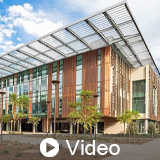
Mindful Design: Building A Research Facility To LEED Standards
Copper Development Association Inc. (CDA) is a U.S-based, not-for-profit association of the global copper industry, influencing the use of copper and copper alloys through research, development and education, as well as technical and end-user support. CDA is committed to promoting the proper use of copper materials in sustainable, efficient applications for business, industry and the home. Copper Development Association Inc. promotes the goals of our members while serving the needs of the users, purchasers, designers and specifiers of copper and copper alloy products.
How do you design an innovative neuroscience research facility to study the brain and bring together biological sciences, physics, engineering, chemistry, and social sciences? In this video course, we explore the state-of-the art Chen Neuroscience Research Building at Caltech. We review how the project team achieved LEED v4 certification by focusing on reducing energy and water consumption in the labs, increasing indoor air quality, selecting sustainable building materials, and using an integrative process to reach their goals. In addition, we discuss the benefits of using copper cladding and its durability, longevity, and aesthetics.
- Describe how design professionals used the integrative process to build an energy efficient and environmentally friendly LEED v4 neuroscience research building
- Discuss the energy performance strategies used to meet LEED v4 BD+C Energy & Atmosphere credits and the major challenges of reducing energy use in the science labs
- Examine how the project team pursued LEED v4 BD+C credits in the Sustainable Sites, Water Efficiency, and Indoor Environmental Quality categories and how this resulted in a healthier and more sustainable building
- Review how the project team pursued LEED v4 BD+C MR credits and used EPDs, HPDs, and other transparency documentation to design a healthy and sustainable research facility
- Identify the benefits of using a high-performance façade system for the exterior of the research building and discuss how its durability, longevity, and aesthetics played a role in its selection





